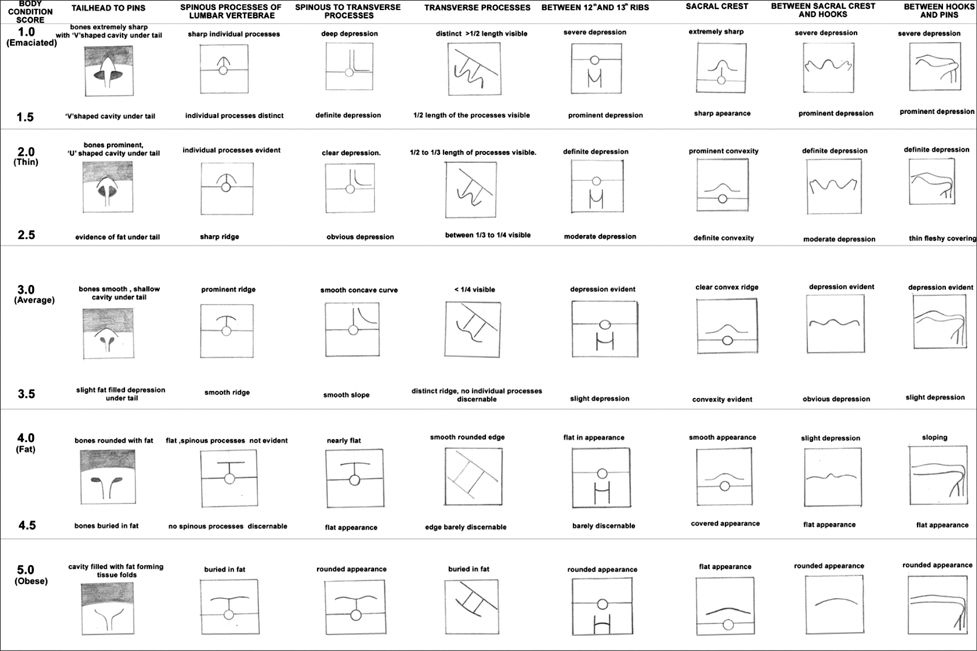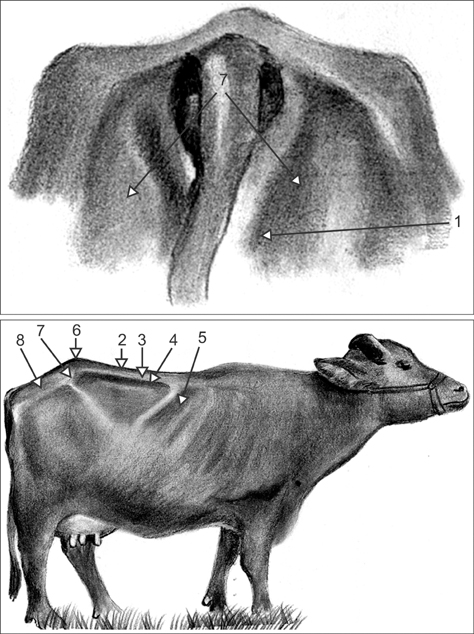J Vet Sci.
2010 Mar;11(1):1-8. 10.4142/jvs.2010.11.1.1.
Development of the body condition score system in Murrah buffaloes: validation through ultrasonic assessment of body fat reserves
- Affiliations
-
- 1Department of Livestock Production and Management, College of Veterinary Science, Tirupati - 517 502, A.P., India. kapasarjanreddy@yahoo.com
- 2Department of Livestock Products Technology, College of Veterinary Science, Tirupati - 517 502, A.P., India.
- 3Department of Dairy Technology Programme, College of Veterinary Science, Tirupati - 517 502, A.P., India.
- KMID: 1106150
- DOI: http://doi.org/10.4142/jvs.2010.11.1.1
Abstract
- The body condition score (BCS) system is a subjective scoring method of evaluating the energy reserves of dairy animals to provide better understanding of biological relationships between body fat, milk production and reproduction. This method helps in adopting the optimum management practices to derive maximum production and maintain optimum health of the livestock. In this study, a new BCS system was developed for Murrah buffaloes. The skeletal check points were identified by studying the anatomical features and amount of fat reserves in slaughtered animals. The scores were assigned from 1 to 5 based on the amount of fat reserves in slaughtered animals. A score of 1 represents least and 5 represents most amount of fat. The skeletal check points identified were ordered based on the amount of carcass fat reserves and scores assigned to prepare a preliminary BCS chart on a 1 to 5 scale at 0.25 increments. The BCS chart was further modified by eliminating the skeletal check points at which the fat reserves were less evident on palpation in most of the buffaloes and a new BCS chart on a 1 to 5 scale at 0.5 increments examining eight skeletal check points was developed. The new BCS system developed was tested for precision in 10 buffaloes for each point of the 1-5 scale by ultrasonographic measurements of body fat reserves. Ultrasonographic measurements showed that as the BCS increased, the amount of fat reserves also increased (p < 0.01), indicating that the BCS adequately reflected the amount of actual fat reserves. BCS was significantly correlated (r = 0.860) with the carcass fat reserves as well as the ultrasonographic fat reserves (r = 0.854).
Keyword
MeSH Terms
Figure
Reference
-
1. Anitha A, Sarjan Rao K, Ramana JV, Satyanarayana Reddy PVV. Body conditions score and its relation to age and physical parameters in crossbred cows. Indian Vet J. 2005. 82:305–308.2. Apple JK, Davis JC, Stephenson J, Hankins JE, Davis JR, Beaty SL. Influence of body condition score on carcass characteristics and subprimal yield from cull beef cows. J Anim Sci. 1999. 77:2660–2669.
Article3. Bittante G, Gallo L, Carnier P, Comin A, Cassandro M. Management and breeding of cows using body condition score. Informatore Agrario. 2004. 60:55–58.4. Bruckmaier RM, Blum JW. B-mode ultrasonography of mammary glands of cows, goats and sheep during alpha- and beta-adrenergic agonist and oxytocin administration. J Dairy Res. 1992. 59:151–159.
Article5. Buckley F, Sullivan KO, Mee JF, Evans RD, Dillon P. Relationships among milk yield, body condition, cow weight and reproduction in spring calved Holstein Fresians. J Dairy Sci. 2003. 86:2308–2319.
Article6. Domecq JJ, Skidmore AL, Lloyd JW, Kaneene JB. Validation of body condition scores with ultrasound measurements of subcutaneous fat of dairy cows. J Dairy Sci. 1995. 78:2308–2313.
Article7. Drame ED, Hanzen CH, Houtain JY, Laurent Y, Fall A. Evolution of body condition score after calving in dairy cows. Ann Med Vet. 1999. 143:265–270.8. Earle DF. A guide to scoring dairy cow condition. J Agric (Victoria). 1976. 74:228–231.9. Edmonson AJ, Lean IJ, Weaver LD, Farver T, Webster G. A body condition scoring chart for Holstein dairy cows. J Dairy Sci. 1989. 72:68–78.
Article10. Ferguson JD, Galligan DT, Thomsen N. Principal descriptors of body condition score in Holstein cows. J Dairy Sci. 1994. 77:2695–2703.
Article11. Gentry LR, Thompson DL, Gentry GT Jr, Del Vecchio RP, Davis KA, Del Vecchio PM. The relationship between body condition score and ultrasonic fat measurements in mares of high versus low body condition. J Equine Vet Sci. 2004. 24:198–203.
Article12. Gerloff BJ. Body condition scoring in dairy cattle. Agri Pract. 1987. 8:31–36.13. Greiner SP, Rouse GH, Wilson DE, Cundiff LV, Wheeler TL. The relationship between ultrasound measurements and carcass fat thickness and longissimus muscle area in beef cattle. J Anim Sci. 2003. 81:676–682.
Article14. Jefferies BC. Body condition scoring and its use in management. Tasman J Agric. 1961. 32:19–21.15. Lassen J, Hansen M, Sørensen MK, Aamand GP, Christensen LG, Madsen P. Genetic analysis of body condition score in first-parity Danish Holstein cows. J Dairy Sci. 2003. 86:4123–4128.
Article16. Lubis A, Fletcher IC. Body condition score in swamp buffalo cows. Research Report. 1985. Bogor: Indonesian Research Institute for Animal Production;31.17. Malik MR, Crao K, Taluja JS, Shrivastava AM. Length and girth as an index to surface pelvimetry in buffalo. Indian J Anim Sci. 1990. 60:1200–1202.18. Malik MR, Taluja JS, Parmar ML. Length and girth as an index to surface pelvimetry in cross-bred cow. Indian J Vet Anat. 1992. 4:54–57.19. Marlowe TJ, Freund RJ, Graham JB. Influence of age, breed, flesh condition, nursing, and season on weight and grade of beef cattle. J Anim Sci. 1962. 21:346–354.
Article20. Perkins TL, Green RD, Hamlin KE. Evaluation of ultrasonic estimates of carcass fat thickness and longissimus muscle area in beef cattle. J Anim Sci. 1992. 70:1002–1010.
Article21. Prasad JM. Principles and Practices of Dairy Farm Management. 2007. 5th ed. Ludhiana: Kalyani Publishers;3.22. Rao KS, Kumar GD, Kailash MM. Influence of calving on body condition score (BCS). Indian J Anim Sci. 2002. 72:882–886.23. Roche JR, Dillon PG, Stockdale CR, Baumgard LH, Van Baale MJ. Relationships among international body condition scoring systems. J Dairy Sci. 2004. 87:3076–3079.
Article24. Sarma DN, Sharma DD. Effect of dietary protein levels and slaughter stage on carcass characteristics of male Murrah buffalo calves. Indian J Anim Nutrition. 1997. 14:1–7.25. Snedecor GW, Cochran WG. Statistical Methods. 1967. 6th ed. Ames: Iowa State University Press;193258–268.26. Spelbring MC, Martin TG, Drewry KJ. Maternal productivity of crossbred Angus X milking shorthorn cows. I. Cow and calf weights and scores. J Anim Sci. 1977. 45:969–975.
Article27. Wagner JJ, Lusby KS, Oltjen JW, Rakestraw J, Wettemann RP, Walters LE. Carcass composition in mature Hereford cows: Estimation and effect on daily metabolizable energy requirement during winter. J Anim Sci. 1988. 66:603–612.
Article28. Wildman EE, Jones GM, Wagner PE, Boman RL, Troutt HF Jr, Lesch TN. A dairy cow body condition scoring system and its relationship to selected production characteristics. J Dairy Sci. 1982. 65:495–501.
Article29. Zulu VC, Nakao T, Moriyoshi M, Nakada K, Sawamukai Y, Tanaka Y, Zhang W. Relationship between body condition score and ultrasonographic measurement of subcutaneous fat in dairy cows. Asian-Australian J Anim Sci. 2001. 14:816–820.
Article
- Full Text Links
- Actions
-
Cited
- CITED
-
- Close
- Share
- Similar articles
-
- Development and Cross-Validation of Equation for Estimating Percent Body Fat of Korean Adults According to Body Mass Index
- An Assessment on the Human Body Composition of Females with Magnetic Resonance Image
- The Relationship between Total Body Fat Distribution and the Broca Index of Obese Students in High Schools
- The Effect of Regular Exercise Program on Body Composition and Body Image in Adults Using One Fitness Center
- The association between dietary fat and body fat in obese adults



